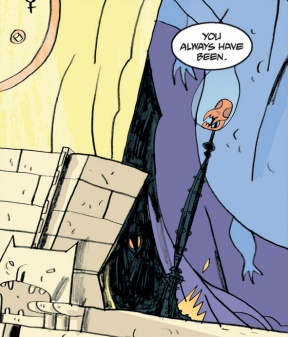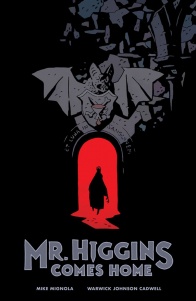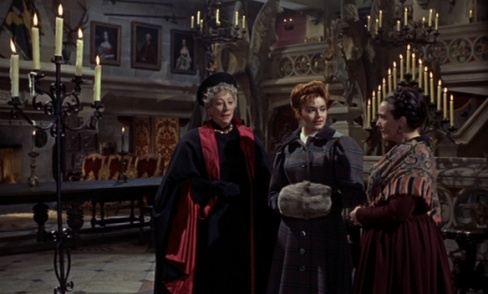
Mike Mignola delivers his second original graphic novel this year, but it’s not a part of the Hellboy Universe. Drawn by Warwick Johnson-Cadwell, this one and done story is truly something unique.
Written by Mike MignolaCover by Mike Mignola
Illustrated by Warwick Johnson-Cadwell
Lettered by Clem RobinsPreparations begin at Castle Golga for the annual festival of the undead, as a pair of fearless vampire killers question a man hidden away in a monastery on the Baltic Sea. The mysterious Mr. Higgins wants nothing more than to avoid the scene of his wife’s death, and the truth about what happened to him in that castle. However, these heroic men sworn to rid the world of the vampire scourge inspire Higgins to venture out and to end the only suffering he really cares about―his own.
This sendup of classic vampire stories sees Mignola teaming with British artist Warwick Johnson-Cadwell (Solid State Tank Girl, No. 1 Car Spotter) for an original graphic novel as outlandish as The Amazing Screw-On Head.
Mark Tweedale: I’ve been excited about this book for a while. The idea of a Mike Mignola book completely unfettered from any existing universe is something I like―not that I don’t enjoy the Hellboy Universe or the Baltimore–Golem Universe (I’m still not sure what we’re calling that one yet)―but they carry a lot of baggage. Little things become big things, and stuff matters. There needs to be a certain amount of cohesiveness in the logic of the universe. In a stand-alone story, the world’s logic is tailored to that particular story, and so it can be more odd.
The oddness of it is right at the heart of what makes “Mr. Higgins Comes Home” so fantastic. It’s like a Hammer Horror film with a splash of Monty Python mixed in.
Brian Salvatore: You must understand, I am a Hammer Horror geek of the highest order. My dad showed me Horror of Dracula when I was seven or eight and it scared me half to death. Christopher Lee’s Dracula was so physically imposing and downright terrifying that I had nightmares about him for years. That isn’t to say I didn’t love it and watch all the other Hammer Dracula films, but he certainly left his mark on me.
So, with that obvious influence, this book was so squarely up my alley. Being a fan of Warwick Johnson-Cadwell’s work only sweetened the pot. This was an incredibly fun mood piece, for which all the classic Hammer triggers were pulled. From the inscription on, the book had me in the palm of its hand.
Mark: Yeah, this book is insanely easy to read. As I flip through it, I keep finding panels that hook me and start to reel me in. Johnson-Cadwell’s art is so perfect for this. He’s excellent at finding details to bring the characters to life. Like when Knox was first introduced, running into the room in a nightshirt, naked knees on display. Straight away I got a strong impression of who Knox is.
And the body language throughout is pitch perfect. The tiniest gesture can make a scene and Johnson-Cadwell clearly knows it. I can think of several panels that made me burst out laughing because of the way a gesture punctuated a line of dialogue or a particular action.
Brian: That scene with Knox is a perfect example—between how he enters the room, what he is wearing, and the expression on his face all gives you all you need to know about the character right away. Johnson-Cadwell’s work is hyper-expressive, and his character work is just exceptional.
At first, I thought it was going to be an odd fit between Mignola’s writing and Johnson-Cadwell’s art. Mignola’s works tend to be more pensive and kept at a distance than what Johnson-Cadwell’s. Due to that, this feels about as loose and emotive as anything Mignola has ever been associated with. In a weird way, this reminded me a little of Jason Latour’s work on “Sledgehammmer ’44.” Obviously, the story is entirely different, and Latour and Johnson-Cadwell’s art styles are not an obvious pairing, but they share a certain kinetic energy. Am I crazy?
Continued belowMark: I can see that. Honestly, I was reminded of how I felt reading Noelle Stevenson’s “Nimona” for the first time. There’s that similar energy of characters that cannot be contained by their linework. It’s so unlike Mignola’s work in that regard.
There’s a panel very early on in “Mr. Higgins Comes Home” that hit home the difference between the way Mignola would draw a panel and the way Johnson-Cadwell would. It was when the vampire Golga mentioned his friends were coming, and there’s a panel with a procession of hearses. If Mignola had drawn it, it probably would have been a stately, ominous procession, but the way Johnson-Cadwell draws it the carriages move like they’ve got Hell’s hounds behind them.
When I look at Mignola’s characters, they almost seem to be carved rather than drawn, and for the most part they move slowly and deliberately; sudden movement or change is reserved for moments of punctuation in the story. Johnson-Cadwell’s characters are always moving―even when they’re static the form shifts around, giving his art a frenetic energy. Comics may be a static medium, but I feel his characters moving constantly. Even in conventional storytelling beats, like when a series of panels push in, he finds ways to introduce extra movement (like at the end of the summoning scene the way he rocks the horizon line from side to side). So when Johnson-Cadwell wants to punctuate a moment, he uses stillness.
I’m used to seeing Mignola’s writing paired with his art or artists that share his sensibilities when it comes to movement, so “Mr. Higgins Comes Home” feels positively explosive. I wasn’t prepared for how well Mignola and Johnson-Cadwell click together.
Brian: It is also notable that Johnson-Cadwell colored his own work which, again, helps break the book from your standard Mignola work in the past. The cover, by Mignola with colors by Dave Stewart, is about as different tonally from the interior pages as you could get.
Johnson-Cadwell’s colors, specifically in all of the scenes at the castle, are truly evocative of the aforementioned Hammer films. The color have muted hues, with the red popping off the page. The coloring decisions help to ground the work a little, which helps the book maintain a little more of a tether.
Mark: Man, that detail went totally over my head. I simply attributed the colors to the vampire masquerade. I’ll be paying more attention to that when I pick up my physical copy.
In regards to the cover, I loved how it has been paired down to its bare essentials. It pops, even at a distance. Also, it seems Mignola made a deliberate choice to avoid drawing any of the main characters. Higgins is reduced to a black, bullet-shaped silhouette―the main feature is Golga crest and the red beyond the threshold. Mignola didn’t take the opportunity to show us his version of Higgins, Meinhart, Knox, or Golga―those characters only exist as Cadwell draws them.
I agree that tonally, it doesn’t match the book, but it did match my expectation before I’d read the book, if that makes sense. Part of the fun of those first few pages (I avoided looking at previews) was having my expectations upended though.

Let’s talk about the story for a second. (Major spoiler warning.) This is a fairly straightforward tale, and yet the ending was totally different and unexpected. I expected a classic showdown between hunter and vampire, but instead, we get a very different encounter.
Mark: Yeah, the whole thing was built around turning expectations on their head. The humor comes from all this build-up, using very recognizable tropes. Like Higgins’s wife. We’ve seen a character like her in so many stories before―the main character’s lover is turned into a vampire, and later she’s weaponized against him, to seduce him or whatever. And Mignola and Johnson-Cadwell set up all the familiar signposting we’d expect, but when that moment comes, Knox accidentally shoots her.
Continued belowI mean, just think of all those moments before where they choose to highlight how defenseless Meinhart and Knox are. Throughout the story their stash of weapons is whittled down to a single silver bullet. And in a moment, they use their only weapon, killing Golga’s vampire plaything, with a host of bloodthirsty vampires downstairs. They are totally screwed.
Then Higgins goes full-blown werewolf, kills all the vampires, and… well, Meinhart and Knox are fine. Mignola and Johnson-Cadwell deflated that built-up tension to magnificent comedic effect.
Three times they establish Meinhart as someone Golga should be afraid of, in the opening scene, then with Golga getting worried that Meinhart’s getting closer, and then once more with the vampire-hunting flashback. Then three times they emphasize Meinhart being disarmed, when Golga’s servant smashes up his luggage, when he’s forced to give up his coat, and finally the conversation about that last bullet. We know how these things work: when something’s said three times you can be damn sure it’s important.
Except in this case it’s not. It is, however, hilarious. I especially loved Meinhart really wanting to keep his coat, but decorum dictates he shouldn’t wear it indoors, and Meinhart is far too British to protest decorum.
Manners defeat Meinhart more than once. He even knowingly walks into a trap because it would be inappropriate to break an appointment.
Brian: It’s funny, in my notes while reading, I jotted down ‘manners’ and ‘propriety.’ Those two words see to hold as much meaning to Meinhart as ‘vampire’ does. Meinhart does all he can to do the ‘right’ thing at all times, even when dealing with truly terrible/evil creatures.
Higgins is obviously a tragic character, because of his horrible transformation, the loss of his wife, and the ending of the book, which does not exactly give him the death he so desired. Now, sure, he knows how he can die now, but he isn’t any closer to getting there.
I will say this, it is odd that Higgins is the titular character here, as his role in the story is important, but by no means the focus on the book. It almost seems like a situation where a name was decided upon first, and then the story came afterwards.
Mark: I think the title is drawing on prose fiction for its inspiration. It reminds me of the sort of title you’d find in a horror anthology, the kind that begs a question. What horror awaits in Higgins’s home? It’s a question reinforced in Mignola’s cover design with that bloody red doorway. I can’t recall ever having read a story of that sort where the titular character was the main character. Certainly for a comic, a medium in which the central character’s name is often the most dominant part of a book’s cover, it’s an unusual choice.
OK, I have to ask… I’m curious which character ended up being your favorite. Mine ended up being Satan. The way he was written, I couldn’t help hearing him talk like John Cleese, but it was the little flourishes Johnson-Cadwell added that I loved the most, like when he gave Meinhart and Knox a little wave before sending them away. Satan seems like a pretty fun guy.
Brian: File this under ‘sentences I never thought I would write,’ but Satan does seem pretty fun here!
I think Higgins is my favorite character here, if only because his story is so sympathetic. You can’t help but feel for him in just about every panel of this book. While he may be the least ‘fun’ person in the book, he is the heart of it. I couldn’t help but love him.
Anything else to add before we close?
Mark: I could go on and on, but I think I should probably stop before I start quoting all my favorite lines. Obviously I had a blast with this book. Mike Mignola’s dialogue is brilliant—not just funny, but evoking characters with such distinct voices—and Johnson-Cadwell’s art has this way of grabbing me and screaming, ‘This way!’ and dragging me down a twisted hallway. Seven hours from now, when I pick up my physical copy from my local comic book store, I’ll definitely be reading it again. I’m giving “Mr. Higgins Comes Home” a 9.5.
Brian: I’ll echo that, which makes it by far the highest grade I’ve given to a book this year. High praise indeed.
Final verdict: 9.5 – C’mon, you’ve totally gotta pick up this book.










